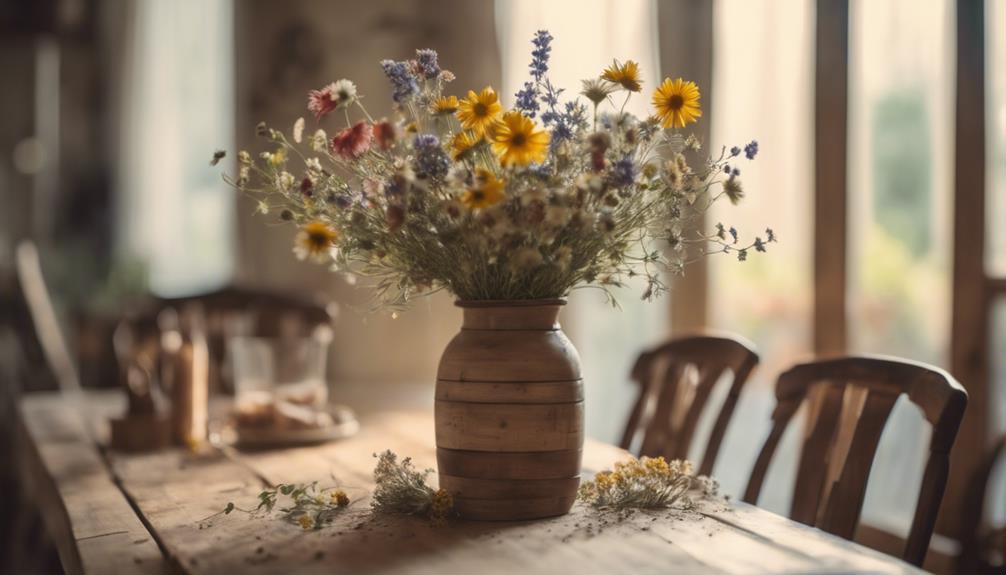Certain foods are seen as luxuries in some regions because of their rarity and local availability. You might notice that items like truffles or saffron come with a high price tag due to labor-intensive harvesting and unique growing conditions. Cultural significance also plays a role, transforming what was once everyday food into gourmet staples. Economic factors, like income levels and market demand, further influence perceptions. As some foods evolve in status, they reflect local traditions and social dynamics. If you explore deeper, you'll uncover even more fascinating insights into these culinary distinctions.
Key Takeaways
- Rarity and labor-intensive sourcing elevate certain foods, like truffles and saffron, to luxury status in regions with limited availability.
- Local culinary practices influence perceptions of luxury, making ingredients like seafood or cassava prestigious in areas where they're scarce.
- Cultural shifts and historical context transform common foods into luxury items, as seen with lobster and caviar, reflecting changing societal values.
- Economic factors, including income levels and market dynamics, affect demand for luxury foods, leading to exclusivity in certain regions.
- Geographic exclusivity and cultural heritage enhance the allure of specific foods, creating varied luxury food markets across different regions.
Understanding Luxury Foods

Understanding luxury foods involves recognizing the factors that elevate certain items to a status of exclusivity and high demand. You'll notice that rarity, high cost, and the difficulty of acquisition play key roles.
For example, truffles and premium wines command high prices due to their unique growing conditions and labor-intensive harvesting methods. In the context of Brazilian cuisine, ingredients like cassava and seafood can be considered luxury items in regions where they're less available, reflecting the regional variations in culinary practices.
A food historian would tell you that historical shifts also shape these perceptions; once considered poor man's food, items like lobster and oysters are now gourmet delicacies.
Economic aspects contribute notably to this luxury status. The income elasticity of demand for luxury foods means that when income decreases, so does spending on these items.
Additionally, climate change poses a serious threat to the availability of luxury foods such as cocoa and coffee, potentially shifting their status back to luxury items as scarcity increases.
Cultural significance can't be overlooked either. Take Japanese Ruby Roman grapes, for instance; they can fetch exorbitant prices at auction due to their meticulous cultivation and presentation standards.
These elements together help define what luxury foods are and why they hold such a special place in society.
Social Dynamics of Food Consumption
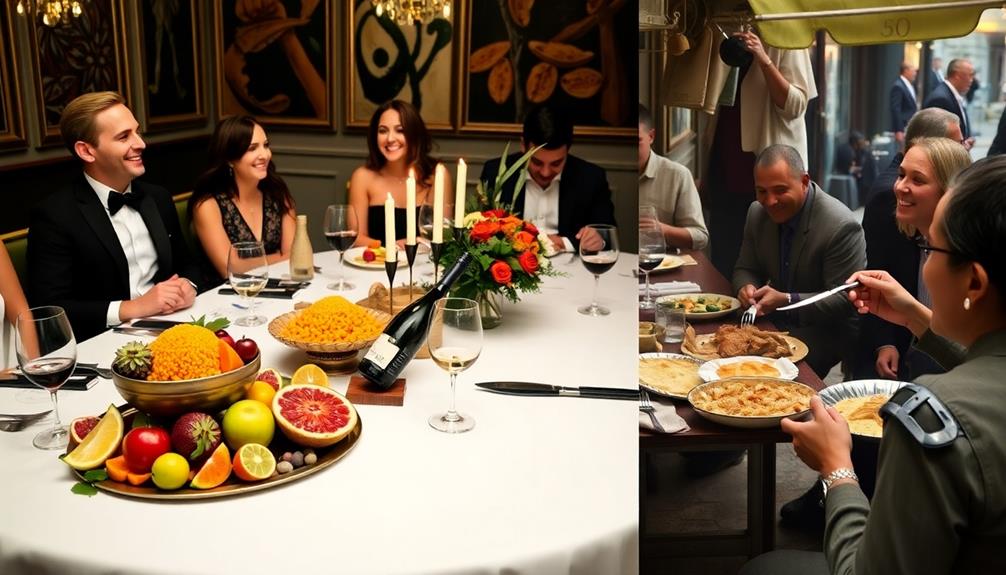
Exploring the social dynamics of food consumption reveals how luxury foods can shape and reflect societal values. In hierarchical societies, luxury foods often enhance social status, creating an exclusive atmosphere that reinforces social distance.
For example, dishes like Chilaquiles: A Mouthwatering Mexican Dish can be elevated with gourmet ingredients, transforming a traditional meal into a luxury experience. On the flip side, in egalitarian societies, these same foods can foster social bonds and communal experiences.
You might notice that the concept of conspicuous consumption illustrates how individuals use luxury foods to display their wealth and social ranking. This behavior often drives social emulation, where you might aspire to attain the status associated with elite consumption, shifting your perception of certain foods from staples to luxuries.
Economic factors can't be ignored either; higher-income individuals are generally more likely to indulge in luxury goods, especially as market dynamics evolve.
Meanwhile, cultural norms play a critical role in the alteration of specific foods from common to luxury status. For instance, items like caviar and lobster, once accessible to the lower classes, are now reserved for special occasions, showcasing how societal values dictate consumption patterns.
Understanding these dynamics helps you appreciate the intricate relationship between food, culture, and social structure.
Historical Significance of Luxury Foods
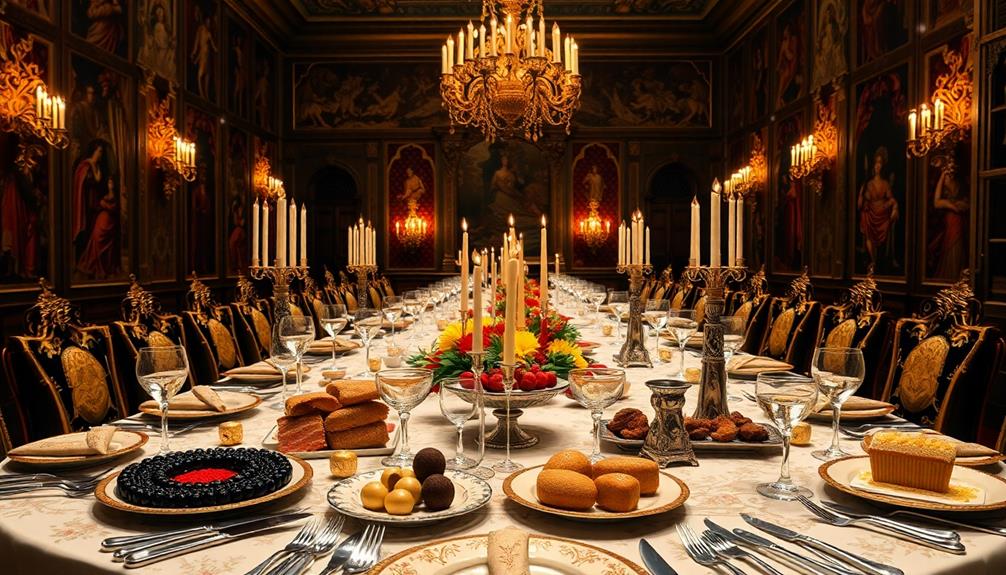
When you look at the history of luxury foods, you'll see how perceptions have changed dramatically over time.
Items like lobster and sugar shifted from being everyday staples to symbols of wealth, influenced by cultural trends and advancements in transportation.
For instance, certain dishes such as Red-Braised Pork Belly have transformed from humble origins to a luxurious experience, particularly during festive occasions.
Understanding these transformations not only reveals the evolution of food but also highlights the intricate relationship between culture and luxury.
Evolution of Food Perceptions
Throughout history, the perception of food has shifted dramatically, influenced by social status, cultural trends, and availability. The evolution of food perceptions shows how items once deemed undesirable can transform into considered luxuries.
Take lobster, for example; in the 19th century, it was viewed as a lowly food, even used as fertilizer. Fast forward, and it's now a gourmet delicacy that graces fine dining menus.
Similarly, oysters changed from being poor man's sustenance in the 17th and 18th centuries to celebrated delicacies at events like the Whitstable Oyster Festival.
Caviar tells a parallel story—initially offered for free during the American Wild West, it became a luxury due to overfishing and rising demand.
Even sushi, which began as a preservation method for low-quality fish, evolved post-World War II into a gourmet dish, thanks to innovative chefs and growing appreciation for Japanese cuisine.
Notably, dishes like Dorayaki (Red Bean Pancake) demonstrate how traditional sweets can gain prominence in modern culinary culture, elevating their status as luxurious treats.
Finally, foie gras's historical journey from ancient Egypt's force-feeding practices to a luxury symbol in Renaissance France illustrates the complex relationship between production methods and food perception.
All these examples highlight how societal values reshaped what we consider luxurious over time.
Cultural Influences on Luxury
The perception of luxury foods is deeply intertwined with cultural influences that shape what society values. Historically, spices were once more precious than gold, fueling global trade and exploration. As demand grew in European markets, these luxury foods became symbols of wealth and status.
Lobster exemplifies this shift; once a common fare for the poor, it transformed into a high-status gourmet dish through improved cooking methods and savvy marketing. Similar transformations can be seen in Italian cuisine, where dishes like agnolotti showcase regional culinary skills and elevate simple ingredients to luxury status.
Similarly, oysters evolved from a last-resort food to a delicacy in the Victorian era, showcasing how social class and consumption trends can elevate specific foods. Sushi also tells a story of evolution. Originally a preservation method for low-quality fish, it evolved into a fine dining experience post-WWII, thanks to cultural appreciation and skilled chefs.
Even caviar, which started as a free bar snack in the American Wild West, became a coveted luxury item due to overfishing and the exclusivity of premium varieties like Beluga.
These examples highlight how cultural influences dictate the status of luxury foods, reflecting broader societal values and trends that continue to evolve over time.
Economic Factors Influencing Luxury Status
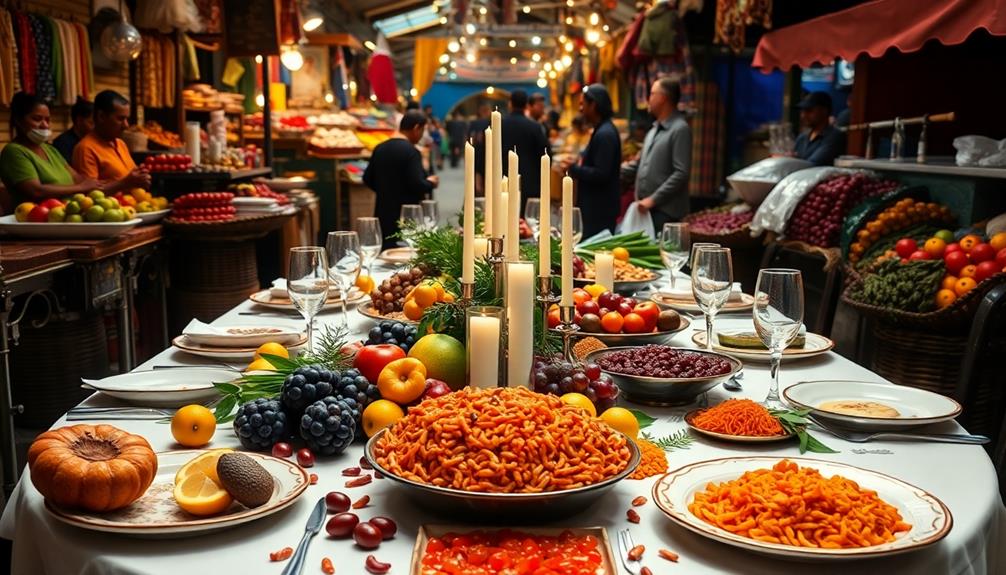
As economic factors shape the luxury status of foods, scarcity and production costs play pivotal roles in determining prices. Items like saffron and truffles, for example, demand high prices due to their labor-intensive harvesting processes and limited availability.
Traditional desserts like Kue Putu, which are made from ingredients like rice flour and coconut, can also become luxury items based on their availability and the skill required to prepare them. When incomes rise, you'll notice an increase in demand for luxury foods, as consumers are keen to spend on premium items like organic and artisanal products.
Historical shifts also affect food luxury status, driven by trade dynamics. Once, spices were valued more than gold and considered luxury items, but expanded trade routes during the Age of Exploration made them household staples.
Additionally, environmental changes and global market fluctuations can spike prices for certain foods. Take vanilla, which has seen soaring costs due to climate impacts and political instability in producing regions.
Social emulation and changing consumer preferences further contribute to the luxury status of foods. For instance, quinoa, once a staple, now commands higher prices as it gains trendy status.
Understanding these economic factors will help you appreciate why some foods are luxuries in certain regions while others are not.
Characteristics of Luxury Food Items
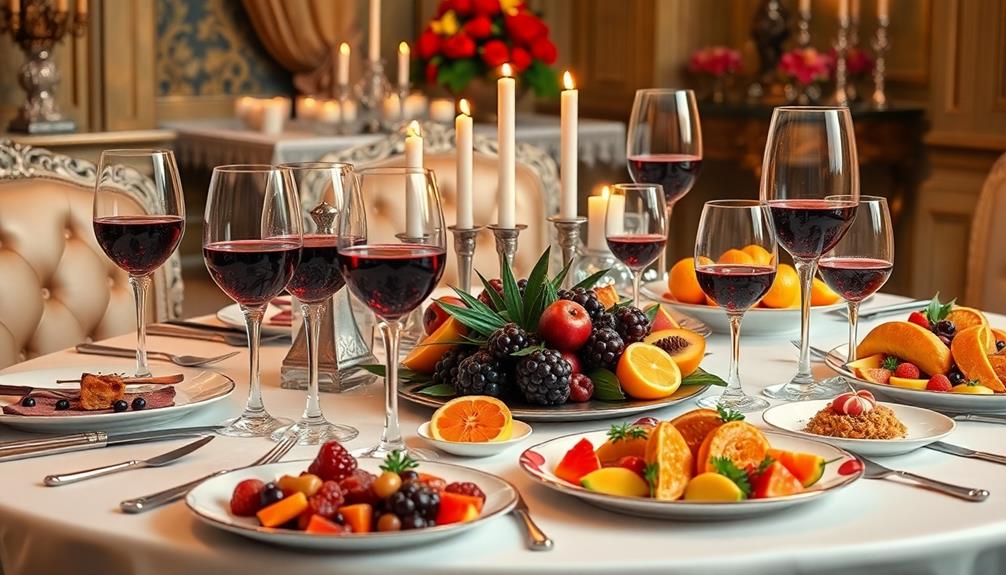
Luxury food items possess several defining characteristics that set them apart from everyday offerings. You'll notice that these luxury foods often come with a high cost, largely due to their rarity and the effort involved in sourcing and preparing them. For instance, truffles and wagyu beef are not just hard to find; they also require specific conditions and labor-intensive processes that elevate their status.
Here's a quick overview of the key characteristics of luxury foods:
| Characteristic | Description | Example |
|---|---|---|
| Rarity | Limited availability often drives demand | Truffles |
| High Cost | Premium ingredients come with a hefty price tag | Wagyu beef, Saffron |
| Meticulous Preparation | Exceptional care in cooking and presentation | Caviar, Foie gras |
Cultural significance can also play a role in determining what's considered luxurious. For instance, Japanese luxury fruits are often elegantly packaged and presented, reflecting deeper social values. Economic factors like global demand and environmental challenges further contribute to the exclusivity of these high-cost items, making them even more sought after.
Changing Perceptions Over Time
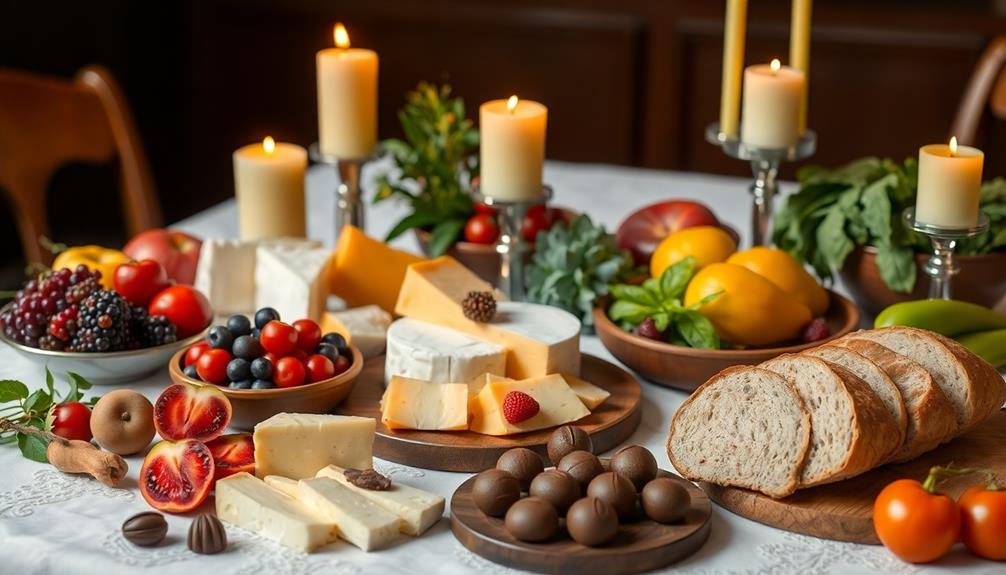
Over the years, perceptions of what constitutes luxury in food have shifted dramatically, influenced by cultural trends, economic factors, and evolving culinary practices.
Take lobster, for instance; it was once considered poor man's food in the 19th century but became a luxury food by the late 1800s due to rising demand. Similarly, oysters evolved from cheap sustenance to a fine dining delicacy, particularly during the Victorian era when they became popular among the wealthy.
Dishes like Mushroom Masala, which combine rich flavors and spices, can also be seen as a reflection of luxury through their intricate preparation and presentation.
Cacao beans also illustrate changing perceptions. Originally, they served as currency for the Mayans, but by the 19th century, they morphed into luxury chocolate products in Europe.
Spices like saffron and vanilla have experienced fluctuations in status over time, remaining high-priced despite past periods when they were more commonplace.
Then there's sushi, which evolved from a method for preserving low-quality fish to a gourmet dish after World War II.
This shift highlights how cultural appreciation and culinary trends can elevate certain foods, reflecting our ever-changing perceptions of what luxury foods truly are.
What's seen as a luxury today might be entirely different tomorrow, shaped by the world around you.
Environmental Impacts on Food Luxury

As climate change reshapes our environment, the availability of certain foods like coffee and vanilla is dwindling, pushing their prices up.
You'll notice that extreme weather events and changing ecosystems are making once-common ingredients scarce, enhancing their luxury status.
This shift in scarcity not only affects how you perceive these foods but also impacts what you're willing to pay for them.
For instance, traditional Greek staples like Horiatiko Psomi (Country Bread) may also see fluctuations in availability and price due to environmental changes.
Climate Change Effects
Climate change is reshaping the landscape of food luxury, making once-common ingredients increasingly scarce and expensive.
Take chocolate, for instance; as cocoa production in Ghana and Ivory Coast faces threats, you might notice chocolate prices climbing, elevating its status as a luxury food.
Traditional dishes like Muamba De Galinha often rely on specific ingredients that could become harder to source due to these environmental changes.
Coffee lovers should brace themselves, too—by 2050, half of the land suitable for coffee cultivation could vanish due to climate impacts, pushing prices higher and making your daily brew a more exclusive commodity.
Extreme weather events, like cyclones, disrupt vanilla production, causing price surges that transform it into a luxury item.
Additionally, the increase in pests and diseases driven by climate change puts spice production at risk, resulting in higher prices for these once-accessible luxury foods.
Even meat, which already demands vast land compared to plant-based proteins, faces challenges.
The environmental costs associated with climate change and potential meat taxes could make meat more expensive, pushing it into the domain of exclusivity.
As the effects of climate change unfold, your relationship with these luxury foods will likely change, highlighting the delicate balance between our environment and what we consider a treat.
Scarcity and Price
Driven by scarcity, the status of luxury foods is increasingly dictated by environmental factors that directly impact availability and production. Take caviar, for instance; its luxury status stems from overfishing and pollution severely diminishing sturgeon populations. As these seafood items become scarcer, their prices climb, driving many to engage in unsustainable fishing practices that could lead to extinction.
This phenomenon is mirrored in the rise of certain Spanish delicacies, such as Txakoli, which, while once a regional specialty, is gaining recognition and demand outside Spain, altering its status in the culinary world.
Moreover, climate change threatens the future of luxury foods like cocoa and coffee, with predictions that half of the suitable land for coffee cultivation may vanish by 2050. This scarcity not only inflates prices but also transforms once-common foods, such as lobster and truffles, into luxury goods due to their limited availability and higher production costs.
You may notice that the disconnect between retail prices and the true costs of production often complicates the pricing of luxury foods. This results in inflated prices that don't accurately reflect the economic or ecological realities.
As you navigate the world of luxury foods, remember that the interplay between scarcity and environmental impacts shapes not just availability but also the value of what you consume.
Cultural Influences on Food Value

Cultural influences shape how we perceive the value of food, often elevating certain items to luxury status. You might find that these luxury foods carry significant cultural perceptions tied to their historical context. For instance, caviar and foie gras are seen as symbols of wealth, while premium fruits like Ruby Roman grapes command astronomical prices in Japan due to their aesthetic appeal.
Here's a table to illustrate how cultural perceptions and historical contexts impact food value:
| Food Item | Cultural Perception | Historical Context |
|---|---|---|
| Caviar | Symbol of wealth and exclusivity | Traditionally served in elite settings |
| Ruby Roman Grapes | Luxury fruit with aesthetic value | Reflects Japan's high standards for quality |
| Lobster | Gourmet delicacy | Shifted from poor man's food to luxury |
Exotic spices, once worth their weight in gold, also showcase how trade and changing economies affect food status. As you explore luxury foods, consider how social status and prestige influence your own perceptions of what's considered indulgent and desirable.
Frequently Asked Questions
What Makes a Food Luxury?
Luxury foods stand out due to their rarity, high cost, and unique flavors. You'll notice that factors like labor-intensive production, seasonal availability, and cultural significance elevate certain foods, making them prized indulgences in culinary experiences.
Why Are Certain Foods More Common in Some Regions of the United States?
Certain foods in the U.S. flourish like wildflowers in their native soil. You'll find blueberries in Maine and barbecue in the South, each shaped by local climate, agriculture, and cultural traditions that define their regions.
Why Do Different Regions Have Different Foods?
Different regions have unique foods due to climate, soil, and cultural practices. You'll find ingredients shaped by local traditions and economic factors, making each region's cuisine a reflection of its environment and history.
Why Do Certain Cultures Eat Certain Foods?
You eat certain foods based on cultural traditions, available ingredients, and historical influences. Your taste buds develop preferences shaped by local practices, creating a unique culinary identity that reflects your region's heritage and values.
Conclusion
Ultimately, the perception of luxury foods varies widely across regions, influenced by social, historical, and economic factors. Did you know that in 2021, the global luxury food market was valued at over $300 billion? This staggering figure highlights how certain foods can embody status and wealth, while others remain humble staples. As tastes evolve and cultural influences shift, what's deemed a luxury today might just become tomorrow's everyday fare. So, keep exploring the fascinating world of food!

